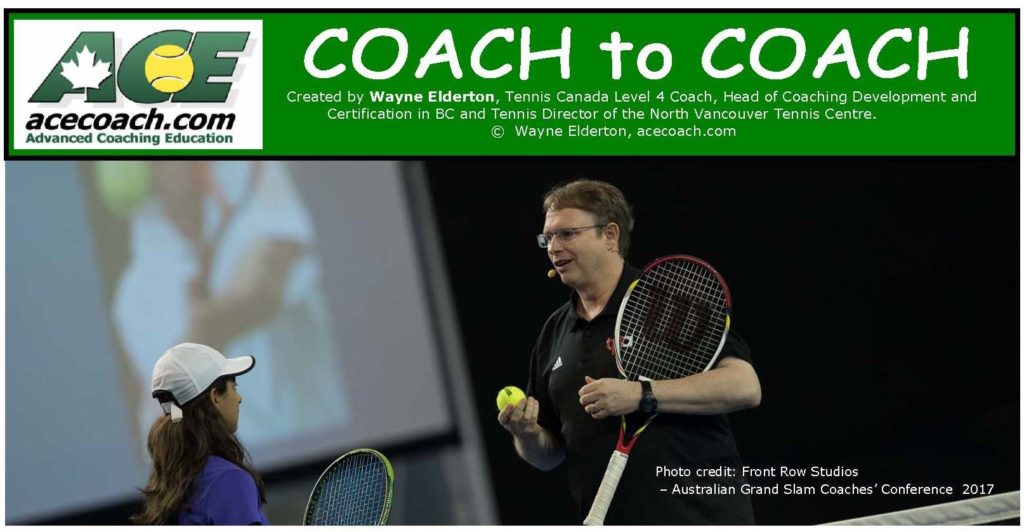
One of the life/career-changing moments I have experienced is when I started to not view myself as a tennis ‘teacher’ but, as a ‘Learning Facilitator’.
This was reinforced more when I would talk to coaches. They could talk for hours about teaching but, when asked the question, “What about learning?”, I would typically get puzzled looks. It may sound nit-picky but, there is a difference between teaching someone something as opposed to helping them learn it.
Learning is ‘sticky’ (it stays with them). Learning is engaging (they buy into it more). Learning is practical (they can use it in real situations). One of my favourite quotes is by an Australian writer who sums it up well: “I forget what I was taught, I only remember what I learned”. When we think about all of our lives and how much was ‘taught’ to us in school, sports, music, etc., we see that only a small percentage stuck with us. That’s the stuff we can really say we learned. Of course, true effective teaching includes learning however, for this article we will use ‘teacher’ as it is commonly misapplied.
I forget what I was taught, I only remember what I learned
pATRICK wHITE -nOBEL WINNING aUSTRALIAN AUTHOR
When I see myself as a ‘teacher’ I may mistakenly believe I am responsible for just what I give out. If somehow, the player doesn’t get it, I can always lay the blame and responsibility on them (“I taught it, if they didn’t get it, that’s their problem”). Like the teacher, a Learning Facilitator is responsible for what they give out but, the big difference is they are mainly responsible for what lands, what actually gets into the player.
Now obviously, the learner has plenty of responsibility however, when I approached it as viewing myself as the one responsible for the learning, it had a significant impact on how I approached players. As a result, sessions became more fun and challenging, an adventure in problem-solving and creativity. If something wasn’t landing on my players I had to, ‘Find a way’ rather than just shift the blame.
To improve learning and performance of anything (whether sports, music, art, medicine, etc.) two essential elements are required:
- Repetition (there needs to be practice)
- Feedback (there needs to be information learned about improving the performance)
So, we see the formula, ‘No feedback = No learning’. But what is coaching feedback? The most common misconception players, parents and even coaches have is that coaching feedback is mostly about, ‘Telling people what they are doing wrong’. That produces a very narrow view of feedback. To have effective communication that impacts and transforms players requires something much more sophisticated and nuanced.
No Feedback = No Learning
A GENERAL DEFINITION
Feedback in it’s simplest form is ‘reflecting a player’s performance back to them’ (feeding-back). It is ensuring players have an accurate mirror so they can see their performance for what it really is and how they can improve it. This is accomplished by either directly communicating to them or, setting up an environment where they gain feedback on their own.
EFFECTIVE FEEDBACK – WHAT IT IS NOT
It is common to see a coach feeding a basket of balls and continually barking feedback at the players. The coach feels they are working hard, the parents like how ‘engaged’ the coach looks, etc. But, is that effective? All too often, from the players’ perspective, the feedback they get is all so much of what I call, ‘Charlie Brown’ feedback. In the Charlie Brown cartoons, when adults talk, they sound like, “wa wa wa wa”. Players learn to tune out this ‘noise’. It doesn’t add to their learning at all. It is all so much, ‘verbal diarrhea’. A coach made aware of the ineffectiveness of this feedback will often justify themselves by saying, “But what I was telling them was right”. The goal is not just to provide ‘correct’ feedback but to provide effective feedback.
MULTI-FACETED FEEDBACK
There are many aspects of feedback that provide a format for making it more effective. How aware are you of the many aspects of feedback? Give yourself a little quiz. Award yourself a point for every point on the list below you could explain to someone else.
In this series of articles, we will explore the many facets of feedback that make it a ‘coaching power tool’:
- Process versus Outcome feedback
- Intrinsic (internal) versus Extrinsic (external) feedback
- Directive versus Cooperative feedback
- Visual, Auditory and Kinesthetic feedback
- Feedback scheduling:
- Terminal vs Concurrent
- Immediate
- Bandwidth
- Faded
- Summary
- Positive versus Negative feedback
- Prescriptive versus Motivational feedback
CONCLUSION
A coaching professional, like other professionals, has domain-specific knowledge and processes. It is not something someone can just walk off the street and do (although many think they can). Coaching effectively is complicated (like surgery is complicated) however, a tennis professional learns all the complicated aspects so they can make it simple for the player.
Since feedback is an essential element in learning, coaches need to be very knowledgeable and masterful at providing players with effective feedback. By having a working understanding of the many aspects, approaches, and types of feedback, a coach has an entire set of coaching ‘power tools’ at their disposal.
This really hits home with me. I have taught for so many years. As I look back I wish Zi could have internalized this way back. I am still teaching so I will start today.
So useful. Planning a players motivation and putting him at the center! This shall change the way I approach my work. Thank you for sharing!